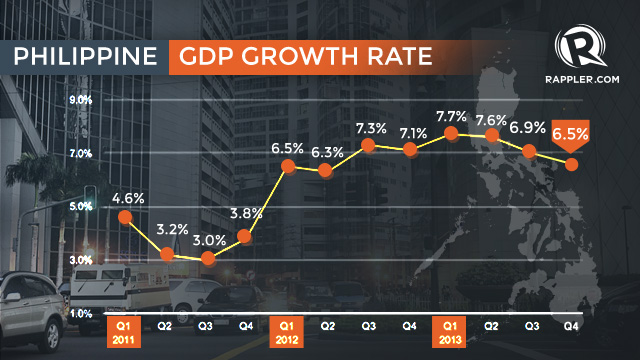SUMMARY
This is AI generated summarization, which may have errors. For context, always refer to the full article.

MANILA, Philippine (3rd UPDATE) – The Philippine economy grew better than expected in 2013 despite a string of disasters including the world’s deadliest typhoon, the government said Thursday, January 30.
The economy grew 6.5% in the last 3 months of the year even as Super Typhoon Yolanda (Haiyan) and the Bohol earthquake claimed thousands of lives and destroyed billions of pesos worth of infrastructure, Economic Planning Secretary Arsenio Balisacan told reporters.
“This is a remarkable turnout,” he said.
The fourth-quarter figure brought full-year 2013 growth to 7.2%, the fastest in Asia after China, which expanded 7.7%.
Growth in 2013 was also the fastest since President Benigno Aquino III came to power, and it exceeded the government’s target of 6% to 7%.
Balisacan said growth was driven by the services sector, particularly trade, real estate and renting, as well as the robust performance of the manufacturing sector.
On the demand side, sustained consumer and government spending, and higher investments contributed the most.
Q4 growth slows

Fourth-quarter growth was slower than the 7.7%, 7.6% and 6.9% recorded in the previous 3 quarters, respectively. (READ: PH grew 6.9% in Q3, not 7%)
Massive destruction caused by Yolanda weighed, but financial aid helped offset this.
“Growth in the fourth quarter could have been 7% to 7.3% if not for Yolanda,” noted Balisacan.
The Philippines endures relentless natural disasters because it is located along a typhoon belt and the so-called Ring of Fire, a vast Pacific Ocean region where many of quakes and volcanic eruptions occur.
However, the final quarter was particularly brutal, with Yolanda leaving 8,000 people dead or missing as it crushed entire communities when it slammed into the Visayas region in November.
The typhoon also ruined the livelihoods of millions of people mostly in poor farming and fishing communities, and a multibillion-dollar effort to rebuild the devastated areas is expected to take many years.
Yolanda came after a 7.1-magnitude quake struck the main tourism provinces of Bohol and Cebu, claiming more than 220 lives.
Balisacan said Yolanda’s impact would continue to drag on the Philippine economy in the first quarter of 2014, as millions of survivors in typhoon-affected areas struggled to rebuild their homes, businesses, farms and fishing boats.
“But we are optimistic that the Philippine economy will remain strong in 2014, especially…(because) the outlook on the global economy is becoming more favourable and as the domestic economy remains robust,” he said.
2014 goals
Malacañang said it was “pleased” with the latest GDP data, adding it was optimistic the country would achieve its 2014 goals through the following:
- focus on growing exports
- reduce the cost and improve the ease of doing business to increase foreign direct investments
- improve linkages between agriculture and industry to boost the growth of these sectors
- promote increased and enhanced employment opportunities to fully harness the vast potential of highly-talented workforce
- implement infrastructure projects, especially in the rehabilitation of calamity areas
- focus on major infrastructure projects, especially in the transport sector, as a significant growth factor
But Presidential Communications and Operations Office Secretary Sonny Coloma emphasized the government’s continued focus on achieving inclusive growth “by reducing poverty and increasing social protection.”
“The updated Philippine Development Plan emphasizes the spatial or area-specific dimensions of development. Hence, government spending is directed at increasing the productivity and reducing the vulnerability of farmers, fisherfolk, and other marginalized sectors of Philippine society,” he said.
Coloma said the programs are so specific, that is targets the poorest provinces and the poorest families.
“They are known by family name, address, number of dependents, even their biometric. What do they do? If they are farmers, are they coconut farmers? If so, the government will gelp them diversify and increase their income… if they do intercropping with ccao and other high-value products, their income will increase 5-6 times. That’s how specific we will be,” he said.
Coloma said fisherfolk will also be provides infrastructure to increase their income, like cold storage so the fish they will harvest can also be made into processed food of higher value. He also mentioned the additional P10-billion appropriation for the 2014 budget to expand the coverage of the government’s main poverty reduction initiative, the Conditional Cash Transfer program.
The government set a growth target of 6.5% to 7% for 2014. – Rappler.com, with a report from Agence France-Presse
Add a comment
How does this make you feel?
There are no comments yet. Add your comment to start the conversation.